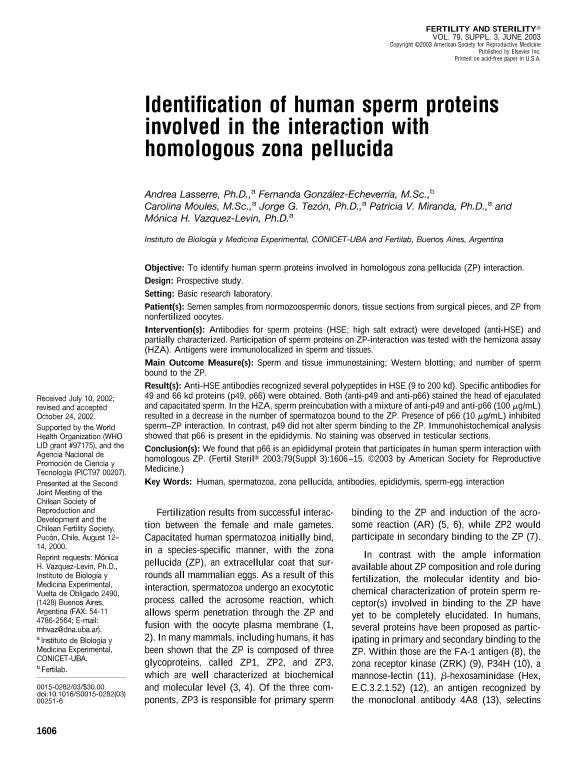Artículo
Identification of human sperm proteins involved in the interaction with homologous zona pellucida
Lasserre, Andrea; Gonzalez Echeverria, Fernanda; Moules, Carolina; Tezon, Jorge Guillermo ; Miranda, Patricia Vivian
; Miranda, Patricia Vivian ; Vazquez, Monica Hebe
; Vazquez, Monica Hebe
 ; Miranda, Patricia Vivian
; Miranda, Patricia Vivian ; Vazquez, Monica Hebe
; Vazquez, Monica Hebe
Fecha de publicación:
06/2003
Editorial:
American Society for Reproductive Medicine
Revista:
Fertility and Sterility
ISSN:
0015-0282
Idioma:
Inglés
Tipo de recurso:
Artículo publicado
Clasificación temática:
Resumen
To identify human sperm proteins involved in homologous zona pellucida (ZP) interaction.Fertilization results from successful interaction between the female and male gametes. Capacitated human spermatozoa initially bind, in a species-specific manner, with the zona pellucida (ZP), an extracellular coat that surrounds all mammalian eggs. As a result of this interaction, spermatozoa undergo an exocytotic process called the acrosome reaction, which allows sperm penetration through the ZP and fusion with the oocyte plasma membrane (1, 2). In many mammals, including humans, it has been shown that the ZP is composed of three glycoproteins, called ZP1, ZP2, and ZP3, which are well characterized at biochemical and molecular level (3, 4). Of the three components, ZP3 is responsible for primary sperm binding to the ZP and induction of the acrosome reaction (AR) (5, 6), while ZP2 would participate in secondary binding to the ZP (7).
Palabras clave:
Sperm
,
Zona Pellucida
,
Fertilization
,
Antibodies
,
Epididymis
,
Sperm-Egg Interaction
Archivos asociados
Licencia
Identificadores
Colecciones
Articulos(CCT - ROSARIO)
Articulos de CTRO.CIENTIFICO TECNOL.CONICET - ROSARIO
Articulos de CTRO.CIENTIFICO TECNOL.CONICET - ROSARIO
Articulos(IBYME)
Articulos de INST.DE BIOLOGIA Y MEDICINA EXPERIMENTAL (I)
Articulos de INST.DE BIOLOGIA Y MEDICINA EXPERIMENTAL (I)
Citación
Lasserre, Andrea; Gonzalez Echeverria, Fernanda; Moules, Carolina; Tezon, Jorge Guillermo; Miranda, Patricia Vivian; et al.; Identification of human sperm proteins involved in the interaction with homologous zona pellucida; American Society for Reproductive Medicine; Fertility and Sterility; 79; 3; 6-2003; 1606-1615
Compartir
Altmétricas



